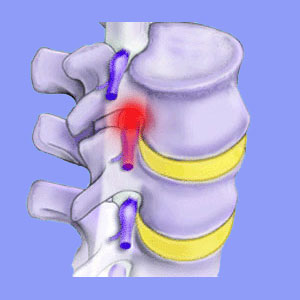
Nerve root compression is one of the most common suspected sources of sciatica. The spinal nerve roots are the structures which branch off the spinal cord, left and right at each vertebral level. These nerves go on to create the entire peripheral nervous system throughout the rest of the anatomy.
If one or more of these nerves become compressed, then it is possible for serious neurological symptoms to occur in the areas of the body served by the affected nerve root. This is commonly referred to as a pinched nerve.
This commentary will discuss compressive neuralgia conditions in the lumbar spine which are thought to enact sciatic nerve expressions. We will look at the causes of structural nerve compression and detail the expected symptomology.
Nerve Root Compression Explained
When the nerve roots branch off the spinal cord, they run through the lateral recess within the spinal canal and then exit through the neuroforamen. It is possible for a nerve root to become pinched within the lateral recess, or more commonly, to become compressed as it enters the foraminal opening. In the case of lumbar pinched nerves thought to cause sciatica, the nerve roots may also be compressed within the central canal, since the spinal cord has already separated into the various tissues of the cauda equina.
The many diagnostic terms which may be used to imply a nerve root is possibly affected by a compression condition include: pinched nerve, nerve impingement, nerve effacement, touching a nerve, mass effect upon a nerve, compression of a nerve or displacement or a nerve root. In most cases, these are used interchangeably, but may have specific meanings to each diagnosis. It is always best to speak to the diagnosing doctor to understand the exact meaning of any term used on an imaging report.
Causes of Neurological Compression
Spinal causes of nerve compression may be varied. Here are some of the most commonly implicated structural conditions blamed for enacting a pinched nerve root:
Herniated discs can affect the nerve roots in the lateral recess in rare cases. Foraminal herniations can pinch nerves as they leave the spinal canal anywhere in the spine. Far lateral herniated discs can even affect nerve roots after they have left the foraminal openings. Central and paracentral herniations can cause or contribute to spinal stenosis, affecting the lumbar cauda equina in the central canal.
Spinal osteoarthritis can enact changes in the vertebral anatomy, including osteophyte formation which may narrow the central canal, compressing nerve roots in the lumbar spine, or may cause bone spurs to narrow the foraminal openings anywhere in the spine.
Spondylolisthesis and other vertebral misalignment issues can literally pinch nerves between displaced bones.
Scoliosis and other abnormal spinal curvatures can literally pinch nerves between atypically positioned vertebral bones, as well.
Nerve Root Compression Truths
Just because a (insert diagnosis here) exists, does not mean it is the source of symptoms. Regardless of the source of a narrowed foraminal opening, the nerve root is rarely affected, unless the space is virtually completely closed off. This is very rare. Additionally, when a nerve root is implicated to be compressed in the central canal or lateral recess, the entire area has to be closed off and pressured by the offending intruding structure in order for symptoms to occur. Once again, this is rare.
Basically, many pinched nerves are misdiagnosed and this is usually easy to prove through neurological correlation. In most patients, the symptoms will be too diverse to be explained sensibly from a single level compressive neuropathy condition.
If your pain has been diagnosed as coming from an impinged nerve, but you have not found relief, it may be time to reconsider the validity of the diagnostic pronouncement. Speak to your neurologist for new evaluation of your symptoms.





